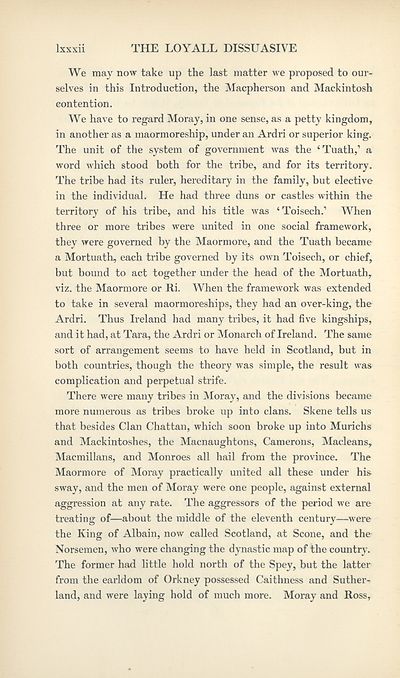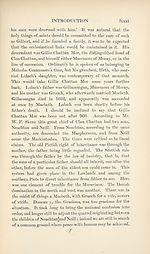Series 1 > Loyall dissuasive
(97) Page lxxxii
Download files
Complete book:
Individual page:
Thumbnail gallery: Grid view | List view

Ixxxii
THE LOYALL DISSUASIVE
We may now take up the last matter we proposed to our¬
selves in this Introduction, the Macpherson and Mackintosh
contention.
We have to regard Moray, in one sense, as a petty kingdom,
in another as a maormoreship, under an Ardri or superior king.
The unit of the system of government was the ‘Tuath,’ a
word which stood both for the tribe, and for its territory.
The tribe had its ruler, hereditary in the family, but elective
in the individual. He had three duns or castles within the
territory of his tribe, and his title was ‘Toisech.’ When
three or more tribes were united in one social framework,
they were governed by the Maormore, and the Tuath became
a Mortuath, each tribe governed by its own Toisech, or chief,
but bound to act together under the head of the Mortuath,
viz. the Maormore or Ri. When the framework was extended
to take in several maormoreships, they had an over-king, the
Ardri. Thus Ireland had many tribes, it had five kingships,
and it had, at Tara, the Ardri or Monarch of Ireland. The same
sort of arrangement seems to have held in Scotland, but in
both countries, though the theory was simple, the result was
complication and perpetual strife.
There were many tribes in Moray, and the divisions became
more numerous as tribes broke up into clans. Skene tells us
that besides Clan Chattan, which soon broke up into Murichs
and Mackintoshes, the Macnaughtons, Camerons, Macleans,
Macmillans, and Monroes all hail from the province. The
Maormore of Moray practically united all these under his
sway, and the men of Moray were one people, against external
aggression at any rate. The aggressors of the period we are
treating of—about the middle of the eleventh century—were
the King of Albain, now called Scotland, at Scone, and the
Norsemen, who were changing the dynastic map of the country.
The former had little hold north of the Spey, but the latter
from the earldom of Orkney possessed Caithness and Suther¬
land, and were laying hold of much more. Moray and Ross,
THE LOYALL DISSUASIVE
We may now take up the last matter we proposed to our¬
selves in this Introduction, the Macpherson and Mackintosh
contention.
We have to regard Moray, in one sense, as a petty kingdom,
in another as a maormoreship, under an Ardri or superior king.
The unit of the system of government was the ‘Tuath,’ a
word which stood both for the tribe, and for its territory.
The tribe had its ruler, hereditary in the family, but elective
in the individual. He had three duns or castles within the
territory of his tribe, and his title was ‘Toisech.’ When
three or more tribes were united in one social framework,
they were governed by the Maormore, and the Tuath became
a Mortuath, each tribe governed by its own Toisech, or chief,
but bound to act together under the head of the Mortuath,
viz. the Maormore or Ri. When the framework was extended
to take in several maormoreships, they had an over-king, the
Ardri. Thus Ireland had many tribes, it had five kingships,
and it had, at Tara, the Ardri or Monarch of Ireland. The same
sort of arrangement seems to have held in Scotland, but in
both countries, though the theory was simple, the result was
complication and perpetual strife.
There were many tribes in Moray, and the divisions became
more numerous as tribes broke up into clans. Skene tells us
that besides Clan Chattan, which soon broke up into Murichs
and Mackintoshes, the Macnaughtons, Camerons, Macleans,
Macmillans, and Monroes all hail from the province. The
Maormore of Moray practically united all these under his
sway, and the men of Moray were one people, against external
aggression at any rate. The aggressors of the period we are
treating of—about the middle of the eleventh century—were
the King of Albain, now called Scotland, at Scone, and the
Norsemen, who were changing the dynastic map of the country.
The former had little hold north of the Spey, but the latter
from the earldom of Orkney possessed Caithness and Suther¬
land, and were laying hold of much more. Moray and Ross,
Set display mode to:
![]() Universal Viewer |
Universal Viewer | ![]() Mirador |
Large image | Transcription
Mirador |
Large image | Transcription
Images and transcriptions on this page, including medium image downloads, may be used under the Creative Commons Attribution 4.0 International Licence unless otherwise stated. ![]()
| Scottish History Society volumes > Series 1 > Loyall dissuasive > (97) Page lxxxii |
|---|
| Permanent URL | https://digital.nls.uk/127548169 |
|---|
| Attribution and copyright: |
|
|---|
| Description | Over 180 volumes, published by the Scottish History Society, containing original sources on Scotland's history and people. With a wide range of subjects, the books collectively cover all periods from the 12th to 20th centuries, and reflect changing trends in Scottish history. Sources are accompanied by scholarly interpretation, references and bibliographies. Volumes are usually published annually, and more digitised volumes will be added as they become available. |
|---|


